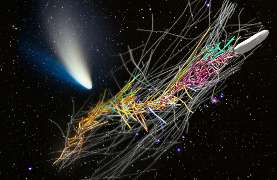Actin Comets. Credit: Plos Biology
(Phys.org) —Actin "comets" are scaffolds of polymer that various bacteria and viruses construct within cells. Party-crashers, like Listeria or Shigella bacteria, are able to seed structures using special patches of their double membrane. They can then jet themselves, so to speak, across their host cell and into a membrane protrusion, ultimately leading to their engulfment by another cell. A recent paper in Plos Biology describes these comets in never before seen detail. The images presented by the researcher reveal how the herringbone patterns of the actin comets are assembled, and also how they act to self-stabilize the directed propulsion of cell invaders.
The researchers looked at a small virus known as a baculovirus. They used a technique known as cryo-electron tomography to build up 3D images of actin comets constructed both in fibroblast cells, and in cell-free recreations of cytoskeletal components. Cryo-EM is basically transmission EM done in liquid nitrogen. The advantage of this technique is that specimens can be observed in their native environment, without fixation or staining. The fragile comet tails could than be preserved against collapse.
The baculovirus is more than 20 times smaller than Listeria, and has a diameter only six times that of an actin filament. Electron tomography can ideally capture snapshots of the baculovirus at work within a thin lamellipodial sheet of the cell. The researchers found that successive filaments of actin were seeded at precise diverging angles, in effect, constraining the virus to orient within the central region. As the virus was bound and unbound, it was ratcheted ahead at speeds up 50 µm/min.
The fishbone-like filament arrays were linked by branch junctions, with four to five filaments contacting the rear of the virus. Actin filaments are polar in that they have a plus and minus direction, each with different polymerization dynamics. The virus was found to be in contact with the faster polymerizing plus end, also known as the barbed end.
In the in vitro cytoskeletal preparation, the researchers could better control exactly what tools were available to the virus. In particular, the concentrations of actin, Arp2/3, gelsolin, ADF/cofilin, and profilin could all be controlled. As every experiment that might be desired here can not be done, the researchers simulated the polymerization process using a detailed model. Among the included details in the model, were cytoplasmic friction, Brownian forces, and forces from the actin filaments themselves.
Their model took into account different modes of tethering of the virus to the actin, and was able to predict certain features of the actin comets including pulling forces and branching patterns. The video below is not of the inside of a cell put of a fluidized bed. A pebble bed, with vibration standing in for heat, paints a more realistic picture of the cytoplasm then a swimming pool model we might have had in mind. As models like the one developed by the authors here grow in complexity to include greater and more varied cytoplasmic features, the fuller picture of these remarkable mechanisms may be better understood.
More information: Paper: Electron Tomography and Simulation of Baculovirus Actin Comet Tails Support a Tethered Filament Model of Pathogen Propulsion, Published: January 14, 2014. www.plosbiology.org/article/in … journal.pbio.1001765
Abstract
Several pathogens induce propulsive actin comet tails in cells they invade to disseminate their infection. They achieve this by recruiting factors for actin nucleation, the Arp2/3 complex, and polymerization regulators from the host cytoplasm. Owing to limited information on the structural organization of actin comets and in particular the spatial arrangement of filaments engaged in propulsion, the underlying mechanism of pathogen movement is currently speculative and controversial. Using electron tomography we have resolved the three-dimensional architecture of actin comet tails propelling baculovirus, the smallest pathogen yet known to hijack the actin motile machinery. Comet tail geometry was also mimicked in mixtures of virus capsids with purified actin and a minimal inventory of actin regulators. We demonstrate that propulsion is based on the assembly of a fishbone-like array of actin filaments organized in subsets linked by branch junctions, with an average of four filaments pushing the virus at any one time. Using an energy-minimizing function we have simulated the structure of actin comet tails as well as the tracks adopted by baculovirus in infected cells in vivo. The results from the simulations rule out gel squeezing models of propulsion and support those in which actin filaments are continuously tethered during branch nucleation and polymerization. Since Listeria monocytogenes, Shigella flexneri, and Vaccinia virus among other pathogens use the same common toolbox of components as baculovirus to move, we suggest they share the same principles of actin organization and mode of propulsion.
Commentary: DOI: 10.1371/journal.pbio.1001766
Journal information: PLoS Biology
© 2014 Phys.org



















